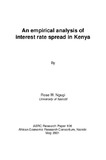An empirical analysis of interest rate spread in Kenya

View/
Date
2001Author
Ngugi, Rose W
Type
Working PaperLanguage
enMetadata
Show full item recordAbstract
Financial reform predicts achievement of efficiency in the intermediation process and
reduced transaction costs, which is proxied by a narrowing wedge between the lending
and deposit rates. Kenya’s experience shows a rise in interest rate spread during the
financial reform and subsequent financial liberalization process, which suggests the failure
to meet the prerequisites for successful financial liberalization. Interest rates were
liberalized amidst inflationary pressure, declining economic growth, financial instability,
the failure to sustain fiscal discipline and lack of proper sequencing of the shift to use
monetary policy tools. At the micro level, our results show that when the profit margin is
threatened, banks sustain a widening spread. Faced with a rising credit risk due to distress
borrowing and poor macroeconomic conditions, banks charge a higher risk premium on
their lending rate. The accumulation of non-performing loans results from a weak legal
system and a poor business environment that squeezes the profit margin, and banks respond
by increasing the lending rate. Policy actions also affect the spread. An asymmetric
response is indicated with the treasury bill rate where lending rates increase with the
treasury bill rate, and become sticky downward when the treasury bill rate declines.
Further, increased implicit costs that accompany tight monetary policy sustain a widening
spread even when inflationary pressure is reduced. Thus a widening interest rate spread
indicates inefficiency in the intermediation process and rising costs of intermediation.
Citation
Rose W. Ngugi (2001). An empirical analysis of interest rate spread in Kenya. AERC Research Paper 106 African Economic Research Consortium, Nairobi May 2001Collections
- School of Economics [105]
